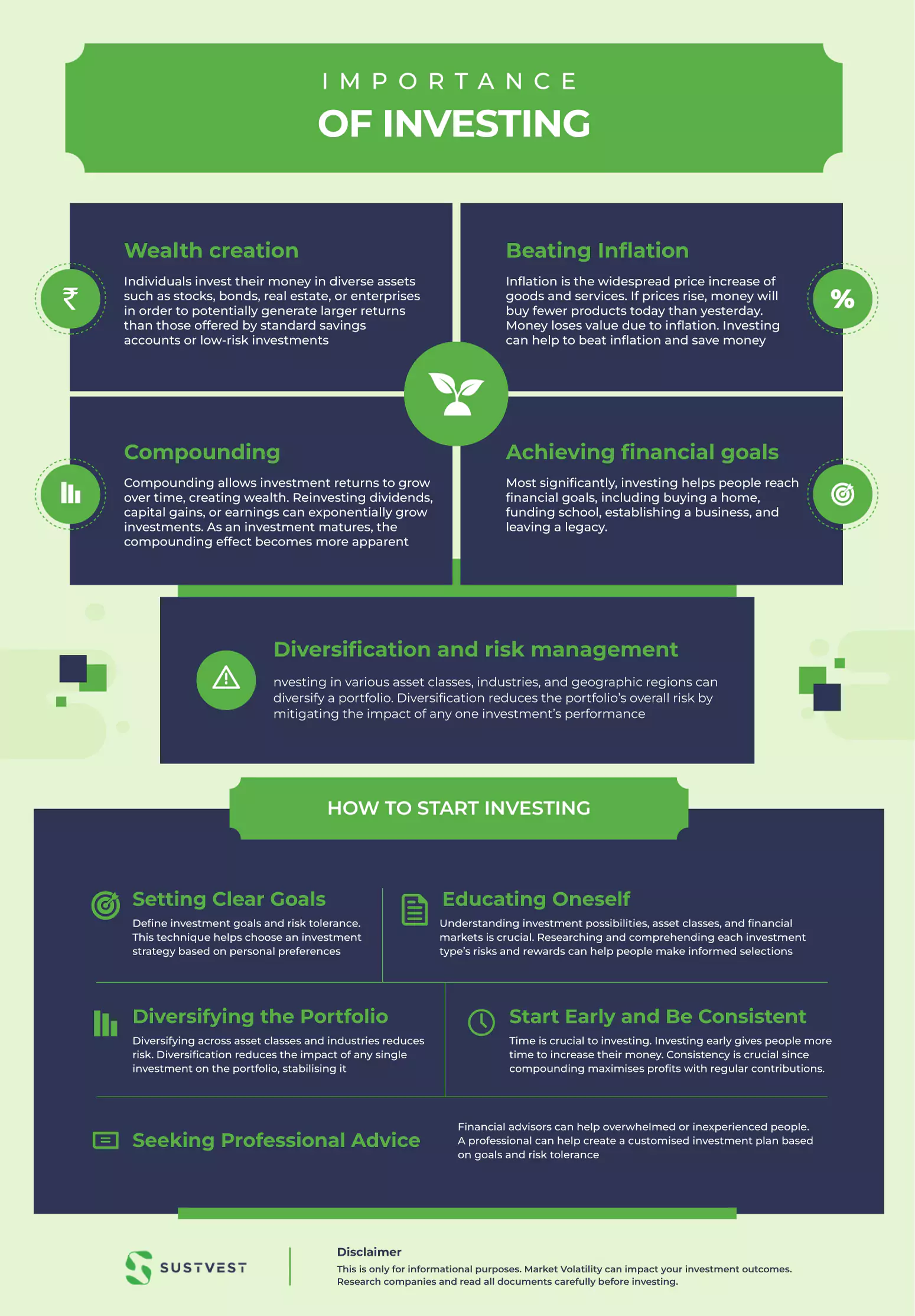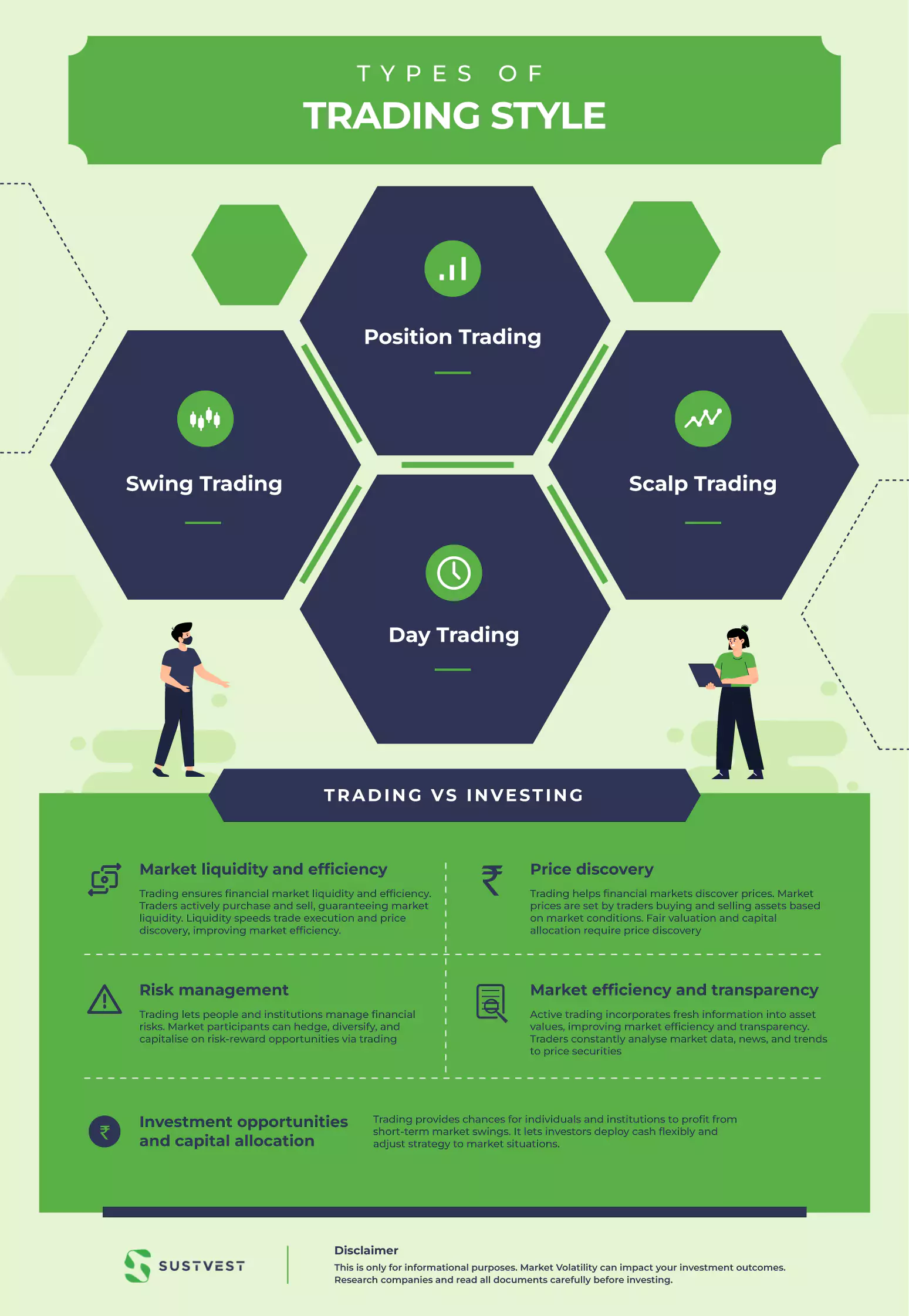The quest for financial resilience is becoming ever more important in a world characterised by ever-changing economic landscapes, unfolding global events, and looming financial crises.
People are trying to figure out how to make their way through this uncertain environment, and two unique paths—investing and trading—have emerged as promising ways forward. Regardless of the path one chooses, one always encounters opportunities and difficulties to take a fair decision.
Despite the unpredictability of the global economy, investing remains a cornerstone for securing one’s financial future. However, trading is a more active and dynamic method of capitalising on market fluctuations.
So, this article is all about looking into the concept and comparison of trading vs investing.

The Concept of Investing
Before delving into trading vs investing, it is imperative that we understand the two concepts separately.
Buying assets that appreciate and generate income or capital gain is investing. Investing time or money can improve your life or others.
One must know the principles of investing if one wishes to grow wealth carefully by constructing a valued portfolio of stocks, mutual funds, bonds, and other investment instruments to reach their financial goals.
Most people hold these investments for years or decades, profiting from interest, earnings, and stock splits. Investors cope with downtrends because they assume prices will rise again, recouping their losses.
Read our article on What is Portfolio Diversification, and Why is it Important here.
Importance of Investing
Investing is an important part of personal finance and asset management since it takes advantage of compounding while accounting for inflation, ensuring that money does not lose value over time. It entails allocating funds or resources with the expectation of future returns or profits.
Investing is important for various reasons given as:
- Wealth creation: Individuals invest their money in diverse assets such as stocks, bonds, real estate, or enterprises in order to potentially generate larger returns than those offered by standard savings accounts or low-risk investments. Over time, the force of compounding can considerably enhance their wealth when investment gains are reinvested and generate new returns.
- Beating Inflation: Inflation is the widespread price increase of goods and services. If prices rise, money will buy fewer products today than yesterday. Money loses value due to inflation. Investing can help to beat inflation and save money. Equity returns have historically exceeded inflation, allowing investors to maintain their quality of life and protect their resources.
- Diversification and risk management: Investing in various asset classes, industries, and geographic regions can diversify a portfolio. Diversification reduces the portfolio’s overall risk by mitigating the impact of any one investment’s performance. Diversification can potentially reduce losses and increase the probability of generating positive returns, even if investments underperform.
- Compounding: Compounding allows investment returns to grow over time, creating wealth. Reinvesting dividends, capital gains, or earnings can exponentially grow investments. As an investment matures, the compounding effect becomes more apparent. Long-term wealth can be gained by investing early and letting it grow.
- Achieving financial goals: Most significantly, investing helps people reach financial goals, including buying a home, funding school, establishing a business, and leaving a legacy. Saving and investing, in the long run, can help people achieve their goals.
How to start Investing
As a novice in the world of investing, there are many queries, including How much money is needed, how to get started, and what are the best investment strategies for novices?
New investors must take a few important steps:
- Setting Clear Goals: Define investment goals and risk tolerance. This technique helps choose an investment strategy based on personal preferences.
- Educating Oneself: Understanding investment possibilities, asset classes, and financial markets is crucial. Researching and comprehending each investment type’s risks and rewards can help people make informed selections.
- Diversifying the Portfolio: Diversifying across asset classes and industries reduces risk. Diversification reduces the impact of any single investment on the portfolio, stabilising it.
- Start Early and Be Consistent: Time is crucial to investing. Investing early gives people more time to increase their money. Consistency is crucial since compounding maximises profits with regular contributions.
- Seeking Professional Advice: Financial advisors can help overwhelmed or inexperienced people. A professional can help create a customised investment plan based on goals and risk tolerance.
Individuals can start their investing journey with a firm foundation and boost their prospects of financial success and stability through these steps.

What is Trading?
Trading is the buying and selling of financial instruments like equities, bonds, commodities, and currencies to profit from short-term price fluctuations. It requires active participation in the financial markets, capitalising on price fluctuations and market trends to execute transactions.
Traders typically use market data, technical or fundamental analysis techniques, and various trading strategies to decide when to enter or abandon trades. In contrast to long-term investing, trading seeks to generate profits within a relatively short time frame, ranging from seconds to days, weeks, or months.
Types of trading style
The duration or period during which stocks, commodities, and other trading instruments are held or sold is referred to as a trading style. In general, trading generally falls into four categories:
- Position Trading: Investment is done for months or even years.
- Swing Trading: The time horizon required to hold positions is for a few days to a few weeks.
- Day Trading: Only holds positions during the day; no positions are held overnight.
- Scalp Trading: Quick trading is done for a few seconds to a few minutes but is never held overnight.
Trading vs Investing- Why is Trading Better?
Here in the debate of trading vs investing, we will prove how trading is better.
- Market liquidity and efficiency: Trading ensures financial market liquidity and efficiency. Traders actively purchase and sell, guaranteeing market liquidity. Liquidity speeds trade execution and price discovery, improving market efficiency.
- Price discovery: Trading helps financial markets discover prices. Market prices are set by traders buying and selling assets based on market conditions. Fair valuation and capital allocation require price discovery.
- Risk management: Trading lets people and institutions manage financial risks. Market participants can hedge, diversify, and capitalise on risk-reward opportunities via trading. Futures contracts and options allow traders to hedge against price fluctuations or speculate on future price movements, lowering risk.
- Market efficiency and transparency: Active trading incorporates fresh information into asset values, improving market efficiency and transparency. Traders constantly analyse market data, news, and trends to price securities. Market mispricing and inefficiencies are promptly addressed. Trading records transactions for investors and authorities, increasing market transparency.
- Investment opportunities and capital allocation: Trading provides chances for individuals and institutions to profit from short-term market swings. It lets investors deploy cash flexibly and adjust strategy to market situations. Efficient trade directs capital to its most productive uses, facilitating economic growth and development.
If you are looking for some fixed-income generation strategies, here is the blog for you- Top 9 Fixed Income Investing Strategies In India

FAQs: Trading vs Investing- What is the Difference?
Trading vs investing – how are they different?
Objectives and timeframes are the primary differences when it comes to trading vs investing. With patience and discipline, investing builds long-term prosperity. On the other hand, trading actively buys and sells stocks to make money on short-term volatility in prices and market imperfections.
Trading vs investing- what’s the difference in terms of time frame?
Short time frames (minutes to months) are prevalent in trading. Traders attempt to profit from swift changes in the market and temporary price variations.
In terms of building wealth over time, which strategy is preferable?
Investments are the best bet if looking to build wealth over the long run. Holding onto investments for long periods of time and taking advantage of compounding can help investors profit from the market’s overall development.
What are some of the possible risks of investing?
Investing risks include market volatility, uncertain economic condition, and the fear of losing money. Different risk is associated with different investment, and it is important to evaluate and manage risk based on the situation and level of risk tolerance.
How to pick between trading or investing?
Investing or trading relies on your financial goals, risk tolerance, and preferences. Investing may be better for long-term growth and market volatility. Trading may be better for those who take risks and aggressive decision-makers.
Conclusion
Investors must understand the concepts of trading vs investing. Both involve financial instruments but diverge in objectives, timelines, and strategies.
Long-term investing fosters wealth accumulation through goal setting, research, and diversifying portfolios. On the other hand, traders leverage price volatility and market inefficiencies for quick profits, using tools like technical analysis and frequent market monitoring.
The choice when it comes to trading vs investing should align with an individual’s goals, risk tolerance, time availability, and investment capital. Visit SustVest today to learn more about investing.

Founder of Sustvest
Hardik completed his B.Tech from BITS Pilani. Keeping the current global scenario, the growth of renewable energy in mind, and people looking for investment opportunities in mind he founded SustVest ( formerly, Solar Grid X ) in 2018. This venture led him to achieve the ‘Emerging Fintech Talent of the Year in MENA region ‘ in October 2019.




